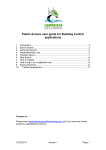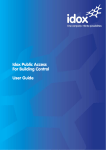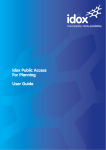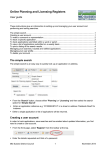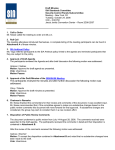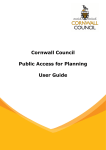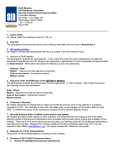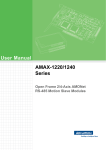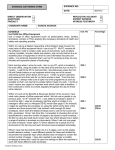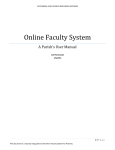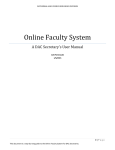Download Public Access User Guide for Idox Planning System
Transcript
Public Access User Guide for Idox Planning System 1 Introduction The Public Access for Planning website is designed to provide users with an easy to use system where they are able to search for and track planning applications and appeals. Users can create a user account, which allows them to: Edit their user profile Save common searches Comment on planning applications during their consultation period. Search for information Examine search results This guide explains how to use the different functions of the planning system on the County Council’s website : www.durham.gov.uk which is available via the following direct link; http://publicaccess.durham.gov.uk 2 Contents Register 4 Log In 7 Forgotten Password 7 Logout 7 My Profile 8 Searching 9 Simple Search 9 Advanced Search 11 Weekly/Monthly Lists 12 Application Details 14 Details 14 Comments 15 3 Register Anyone can use the IDOX Public Access For Planning site to view planning applications, but to take advantage of the advanced profile features that allow you to save searches and track applications you must first register a user account 1. To create a new user account click on Register in the menu bar. 2. Register your personal details by completing the following fields: • Title – select the title you wish to be addressed by. • First Name – enter your first name. • Surname – enter your surname. • Email Address – enter your email address. The system will ask you to re -enter to confirm that it is correct. • Password – enter a password that will allow only you to access your account. Repeat it in the box below. User Note Passwords must be a minimum of five characters and may not contain spaces. Enter the password again below to confirm that it is correct. 3. Click on Next. 4 4. Enter your Postcode, then press Next. 5. Select your address from the drop down list, then click on Next. 6. If your address is not listed, select My address is not on the list and click on Next. 7. Enter your address details in the appropriate fields, then click on Next. 5 8. Click to read the Terms and Conditions and Privacy Policy that apply to the use of this site. When you have done so, tick the check box to indicate that you agree to them. 9. Check that your personal and login details are correct. To register them click on the Next button. 10. An email will be sent to the address you entered. When the email arrives, click on the link to be returned to the IDOX Public Access For Planning site. 6 Log In In order to use the full range of features offered by IDOX Public Access For Planning you need to log in to the site using the user name and password you provided when you registered your account. 1. Click on Login on the home page. 2. Enter your user name and password, then click on the Login button. Forgotten Password 1. If you forget your password, click on the Forgotten password? link. 2. Enter your email address and then enter a new password twice. Press the Save button. 3. A confirmation email will be sent to your email address. When it arrives, click on the confirmation link. You will now be able to log in with your new password. Logout When you are finished using IDOX Public Access For Planning, remember to log out by clicking on the Logout button in the menu bar. 7 My Profile Once your account has been created you can access your My Profile area. This allows you to change your personal details as well as manage your searches and applications. • Profile Details – your full personal details • Saved Searches – a list of searches which you have saved • Notified Applications – notifications that applications that you are tracking, or are the subject of saved searches, have been modified • Tracked Applications – a list of applications that you have elected to track. 1. To access your profile page select Profile Details from the My Profile drop down list in the menu bar. This page allows you to view the details you registered with. You can change any of those details or update your password. 2. To update your password click on Change my password. 3. Enter your email address and then enter a new password twice. Press the Save button. A confirmation email will be sent to your email address. When it arrives, click on the confirmation link. You will now be able to log in with your new password. 4. To change your details click on Update my personal details. 8 Searching There are four different types of search which can be used to identify a planning application or appeal; · Simple search – allows the user to search quickly using an application or appeal number, a single line of address (e.g. 1 High Street) or a postcode. · Advanced search – allows the user to search using a wider combination of options (e.g. ward, decision, committee date). · Weekly/monthly list search – allows the user to search for applications whose status has been validated or decided within a particular time period. · Map search – allows the user to search for applications using an interactive map tool. Simple Search A simple search allows the user to search quickly by entering some text that will help identify the relevant application(s) or appeal(s). 1. Select Simple Search from the Search drop down list. 2. Click to select whether you want to search for: • Applications • Appeals • Enforcements 3. Enter some text in the Search box that will correspond to one of: • application reference number (for example, “12/00317/FPA”) • post code (for example, “DH1 5UL”) • part of an address (for example, “1 High Street”, “Council Offices”). 9 4. Click on the Search button to display the results of your search. 5. The number of results being displayed (out of the total number of results) is shown. If there are more results than fit on to one page you can navigate between the results pages either by clicking on Next to view the next page or by clicking directly on the page number. 6. A map of the relevant area is displayed. Click on Show results on large map to see the locations of the search results in more detail. 7. To view a search in detail, click on its title. 8. If there are too many results, or if the results do not contain the applications you are looking for, you can go back and amend your search criteria. To do this, click on the Refine Search button. 9. If this search is one that you will reuse, click on the Save Search button. You can edit the search name here and select whether to receive an email if new applications arrive that match the search criteria. Click on Save to save the search. 10. To display the current page of search results in a printable format, click on the Print button. Click on Print again in the new window to send the page to your local printer. Press Close when you are finished with this window. 10 Advanced Search An advanced search allows the user to build a complex combination of specific criteria on which to search for information. 1. Select Advanced Search from the Search drop down list. 2. Click to display a search page specific to: • Applications • Appeals 3. If you know a reference number that identifies a specific application or appeal enter it in the appropriate box. 4. The Application/Appeals details allow you to specify an application type, status or decision as well as location details, which include ward, parish and address information. Enter any combination of these details as appropriate. 5. Enter a Date range to define the period during which the application or appeal was lodged, validated or decided by court or inspectorate. 6. Click on the Search button to display the results of your search. 7. The number of results being displayed (out of the total number of results) is shown. If there are more results than fit on to one page you can navigate between the results pages either by clicking on Next to view the next page or by clicking 11 directly on the page number. 8. A map of the relevant area is displayed. Click on Show results on large map to see the locations of the search results in more detail. 9. To view a search in detail, click on its title. 10. If there are too many results, or if the results do not contain the applications you are looking for, you can go back and amend your search criteria. To do this, click on the Refine Search button. 12. If this search is one that you will reuse, click on the Save Search button. This search will appear in your Saved Searches. 13. To display the current page of search results in a printable format, click on the Print button. Click Print again in the new window to send the page to your local printer. Weekly/Monthly Lists The weekly/monthly lists search allows the user to search for applications according to the week or month in which they were either validated or decided. 1. Click on the Weekly/Monthly Lists tab. 2. Click on Weekly List or Monthly List to select which list you want to search. 3. Select the application status from the Status drop down list. 4. You can narrow your search to a particular area by selecting from the Parish drop down list. 12 5. Specify the Week or Month by selecting from the drop down list. 6. You can display applications which were validated or applications which were decided during the selected time period. Make the appropriate selection under Show applications. 7. When you have made your selections, click on the Search button. • You can re-order the list by reference number, date received, description or status. Select one of these from the Sort by drop down list, then click on Go. • To change the direction of the list select Ascending or Descending from the Direction drop down list, followed by Go. • To change the number of results displayed, select from the Results per page drop down list, followed by Go. • If there are more results than fit on one page, navigate to further pages by clicking on Next or by clicking on the Page Number directly. 8. To add this search to your Saved Searches page, click on the Save Search button. 9. You can print off this list by clicking on the Print button. 10. The application locations are displayed on a Map on the right. You can display a larger map by clicking on Show results on large map. 11. If there are too many results you may want to add more information to the Search. Click on the Refine Search button. 13 Application Details Once you have selected an application from your search results the application details will be displayed. The application details are displayed at the top of the page, with further tabs below containing all of the relevant information about the application. Details 1. Click on the Details tab to display the full details relating to the application. 2. The Application Details are split up into four tabbed sections. Click on the appropriate tab to display those details: • Summary – displays the basic information pertaining to the application. The summary also identifies the number of the cases and properties that have been added to this application. Click on one of these to view them. 14 • Further Information – displays additional information about the application that was not included in the summary. • Important Dates – displays the dates on which important events in the lifespan of the application occur from initial submission through to the decision. Comments 1. Click on the Comments tab to display comments that have been made about this application. ` 2. Comments can either be submitted by members of the public or by people who have been consulted about the application. Click on Public Comments or Consultee Comments as appropriate. 3. You can re-order the list by the date the comment was added or by the commentor’s name. Select one of these from the Sort by drop down list, then click on Go. 4. Comments are displayed showing the name of the commentor and their stance on the application (objects, supports or neutral). 5. Click on Expand All to view all of the comments on the page. Click on Collapse All to hide them all again. 15 6. To add a comment to the list, click on Make a Comment. (Need to be registered) 7. Your name and address are added automatically to the form. If these are not correct, click on update my personal details and make the appropriate changes. 8. Add your remaining contact details in the appropriate boxes. 9. The Commentor Type drop down list describes the type of people who may need to make a comment about an application. These include councillors, neighbours to the application address and members of the public. Select the one that applies to you. 10. In the Reason for comment box select one or more of the offered reasons for making your comment. 11. Enter the details of your comment in the Your Comment box. 12. If you want to receive an email confirming that your comment has been received, check the Send me an email confirming my comments box. 13. When you have completed all the details, click on the Submit button. Your comment will be sent to Planning and a record will appear on the Comments page for this application in due course. 16


















